It seems we can’t find what you’re looking for. Perhaps searching can help.
Sign Up for newsletter!
Subscribe to get the latest eBook!
Hotline






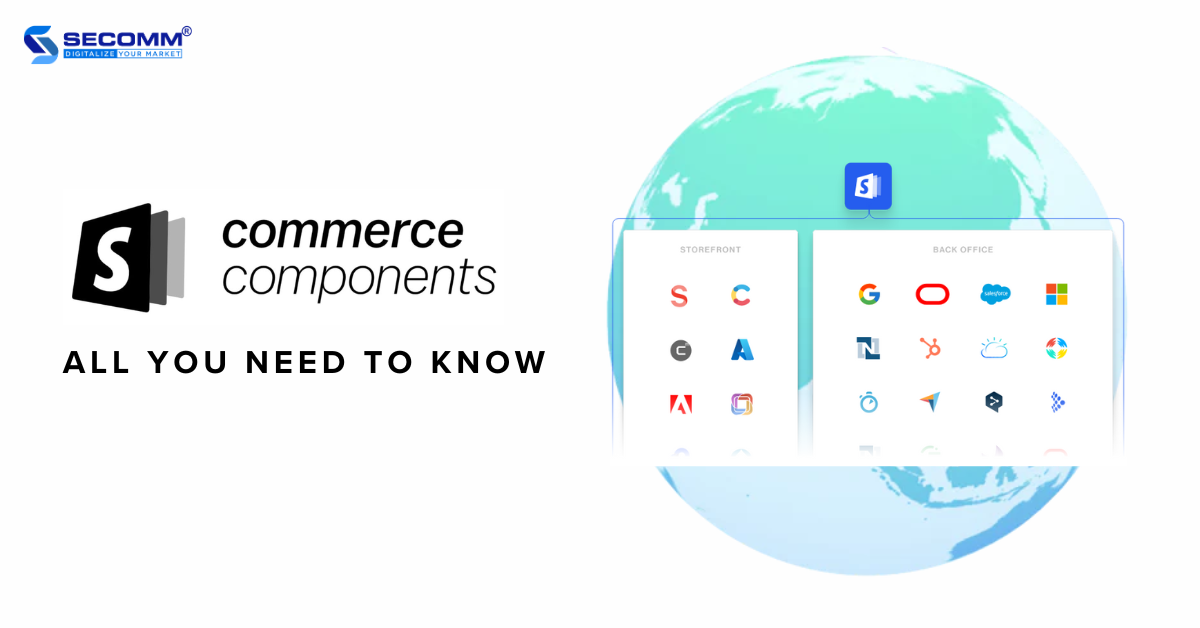
Today, with the growing demand for flexible and scalable eCommerce system development, large-sized businesses turn their attention to solutions like Headless, Microservices, and Composable Commerce. The Composable approach will allow you to integrate independent components to tailor and enhance the eCommerce experience.
Knowing this insight, Shopify has unveiled the Commerce Components solution, offering you — as a large-sized business — the most straightforward approach to deploying Composable Commerce.
Learn more: What is Composable Commerce?
Commerce Components is an innovative tech stack designed for large businesses. Rather than introducing new features, the company has transformed its infrastructure into modular components that can be combined to build and customize adaptable eCommerce websites. This means you can select components based on your deployment needs and seamlessly integrate them into your existing tech stack using flexible and unlimited API connections, ensuring a smooth customer experience across all devices.
“We’ve always approached innovation by anticipating what retailers need and then providing those solutions,” said Harley Finkelstein, president of Shopify. “Commerce Components opens our infrastructure so enterprise retailers don’t have to waste time, engineering power and money building critical foundations it has already perfected, and instead frees them up to customize, differentiate and scale”
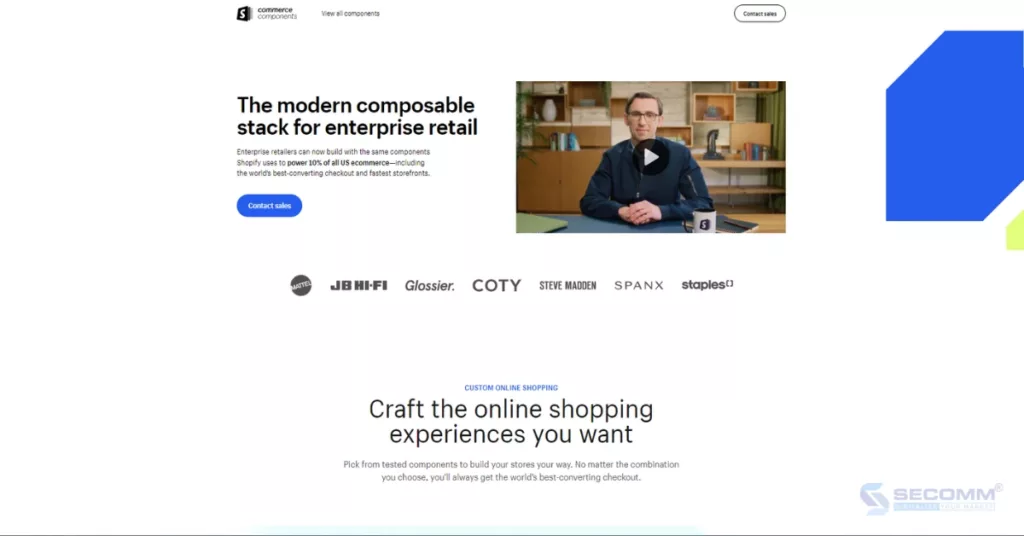
The solution offers six main categories including over 30 components, allowing you to build a tailored solution that aligns with your needs.
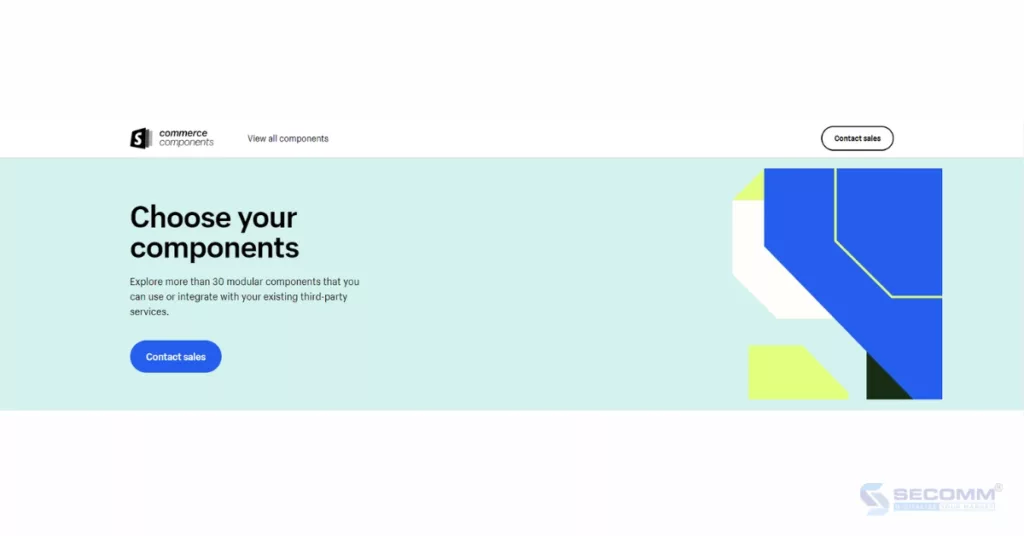
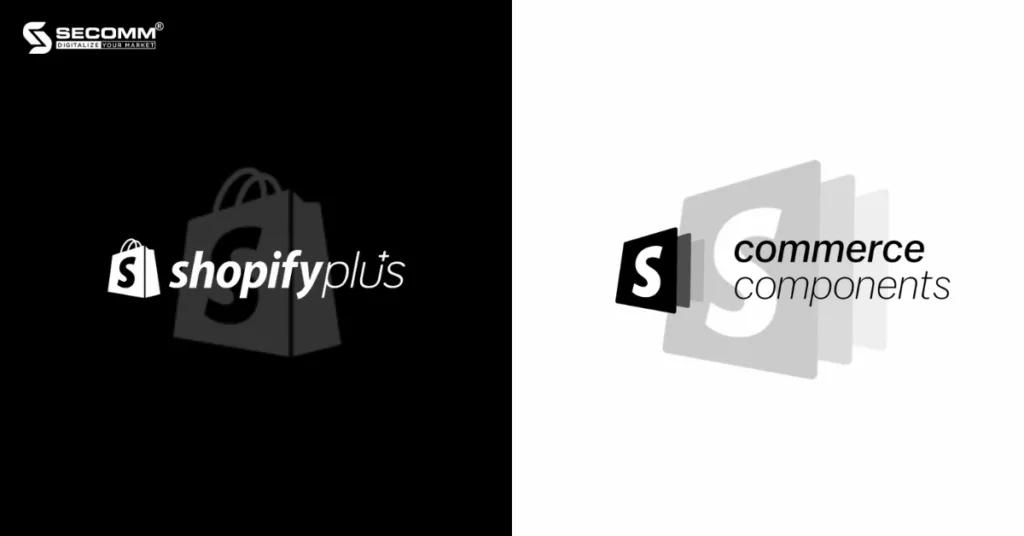
Although both ‘Plus’ and Components are enterprise eCommerce solutions, they differ in several aspects:
If you don’t prefer to deploy pre-packaged eCommerce platforms. Composable architecture is the ideal choice. It allows you to select and purchase components based on your needs, integrate them into your existing systems, and customize them.
With its modular architecture, the tech stack provides unlimited API connections, meaning there is no limit to the number of components and add-ons that you can use to build your tech stack.
Moreover, since components are entirely independent, you can add, remove, and modify components without affecting the entire system.
Commerce Components employs a pricing model structured around the level and quantity of components used. This means you only pay for the components you require. Furthermore, as you acquire and utilize more components, you’ll benefit from increasingly significant discounts.
Additionally, the annual payment structure of Components helps you facilitate precise cost predictions.
Since its inception, the platform has proudly highlighted the trust and adoption of its solution by major global businesses. Notable among these are Glossier, JB Hi-Fi, Coty, Steve Madden, Spanx, and Staples.

Leading U.S. toy brand Mattel is one of the first enterprises to successfully implement this technology solution. Sven Gerjets, Mattel’s CTO, said in a statement.
“We first worked with Shopify on a project called Mattel Creations, a platform for creators to reimagine the most iconic toys in the world. Creations empowered Mattel to move quickly, meet our customers where they are, and most importantly leverage its infrastructure to scale globally. It was hugely successful, and we’re excited to transform our brand offerings using Commerce Components.”
The trust placed by Mattel and other industry leaders forms a solid basis for expecting the ongoing success of this new solution, extending its impact not only within the U.S. market but also on a global scale.
Final Thoughts
In the past, large businesses often favored open-source platforms like Magento or Salesforce due to their customizable and flexible expansion capabilities. However, in today’s landscape, SaaS platforms, particularly Shopify, offer innovative solutions for developing Composable or Headless Commerce.
In 2021, the company launched the Hydrogen + Oxygen solution to enhance Headless Commerce development. Continuing this trend into early 2023, they once again surprise the industry with Commerce Components, designed for deploying Composable Commerce.
This move highlights its commitment to anticipating and responding to customer needs, earning the trust of large enterprises in the face of competitive rivals.
Reach out or call the SECOMM hotline at 028 7108 9908 for a more in-depth understanding of Commerce Components by Shopify and to explore the implementation of Headless Commerce or Composable Commerce.
 2
2
 11,072
11,072
 0
0
 1
1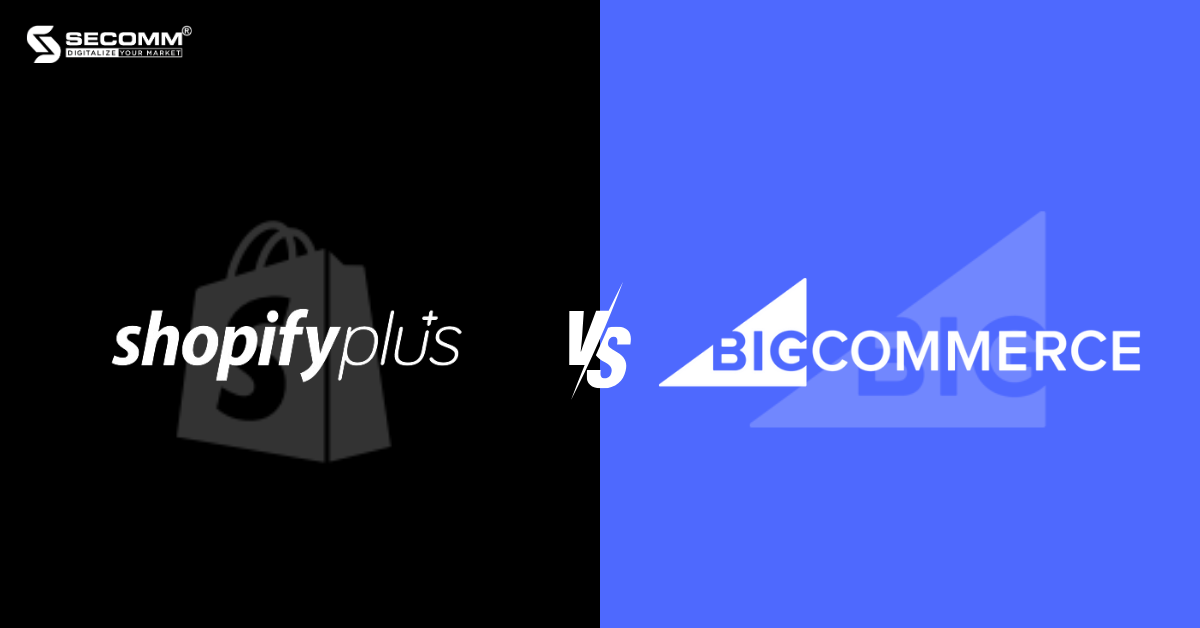
In today’s eCommerce landscape, it isn’t just open-source platforms that can meet the complex development and customization needs of large-scale enterprises, but SaaS platforms are also steadily rising with significant improvements. Among them, two SaaS platforms designed specifically for large enterprises are Shopify Plus and BigCommerce Enterprise.
However, these two platforms have many key differences. This article aims to clarify the pros and cons of each platform and compare the differences between the two platforms to help you — as a business leader — make well-informed decisions.
Learn more: Shopify vs BigCommerce: Which platform is right for you?
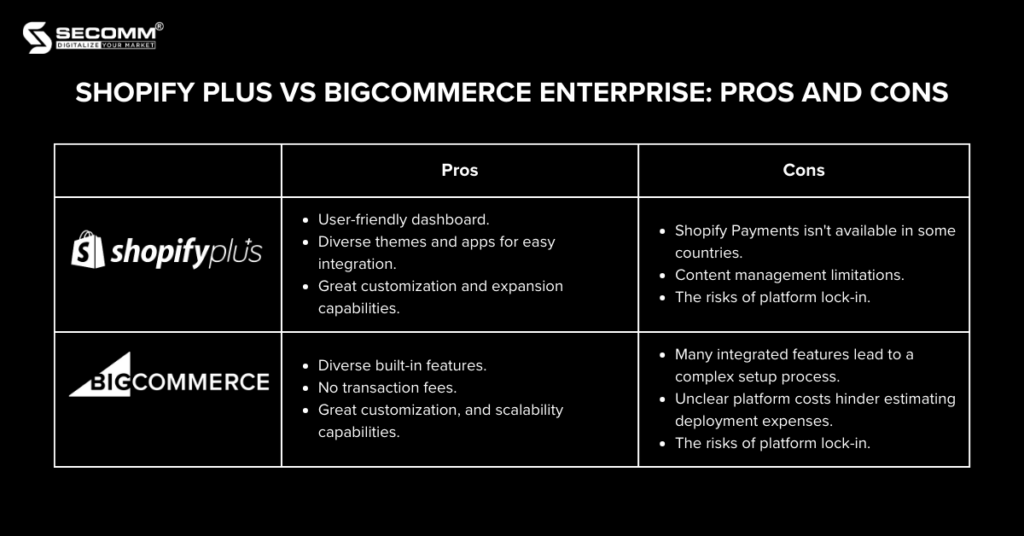
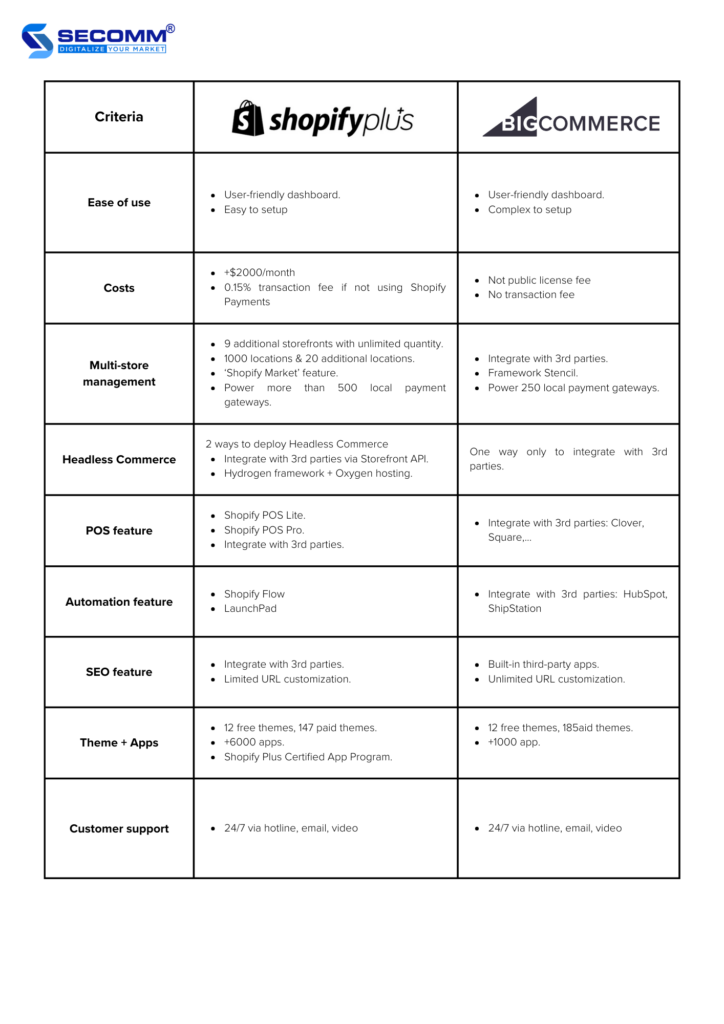
Both platforms are recognized for their user-friendliness compared to open-source platforms. Their intuitive dashboard and user-friendly navigation, along with features like drag-and-drop editing, extensive documentation, and 24/7 support, make them accessible for users of varying technical expertise.
However, Shopify, known for its inherent user-friendly design, ensures that users, whether using the Plus version or the regular ones, can easily explore and set up their eCommerce website with efficiency.
Both these two premium solution platforms — which are Shopify Plus and BigCommerce Enterprise — cater to the deployment needs of large enterprises, these platforms offer advanced features and technologies that require some learning.
For example, the ‘Plus’ users need to grasp the Liquid template language, while those opting for the ‘Enterprise’ may benefit from understanding the Google Cloud Platform for optimizing website performance.
BigCommerce, renowned for its built-in features, continues this trend with the ‘Enterprise’ version. Some features may suit specific businesses but might be unnecessary for others. While BigCommerce allows flexibility for customizing and configuring these advanced features, it can introduce complexity and intricacy into the setup process.
Similarly to other premium solutions on SaaS platforms, the license fee will depend on the deployment requirements and the current scale of the business. BigCommerce doesn’t disclose the fee publicly, requiring businesses to directly contact the platform for tailored consultation and pricing.
On the other hand, Shopify Plus has a license fee starting at $2000 per month. Once you reach a monthly revenue threshold of $800,000, the platform fee becomes revenue-based, amounting to 0.25% of monthly revenue, capped at $40,000 per month or $480,000 per year.
Considering transaction fees is also important. While BigCommerce doesn’t charge transaction fees, Shopify Plus charges a 0.15% transaction fee for not using Shopify Payments.
To estimate deployment costs effectively, you should partner with development agencies and engage in detailed consultations with BigCommerce or Shopify for comprehensive guidance.
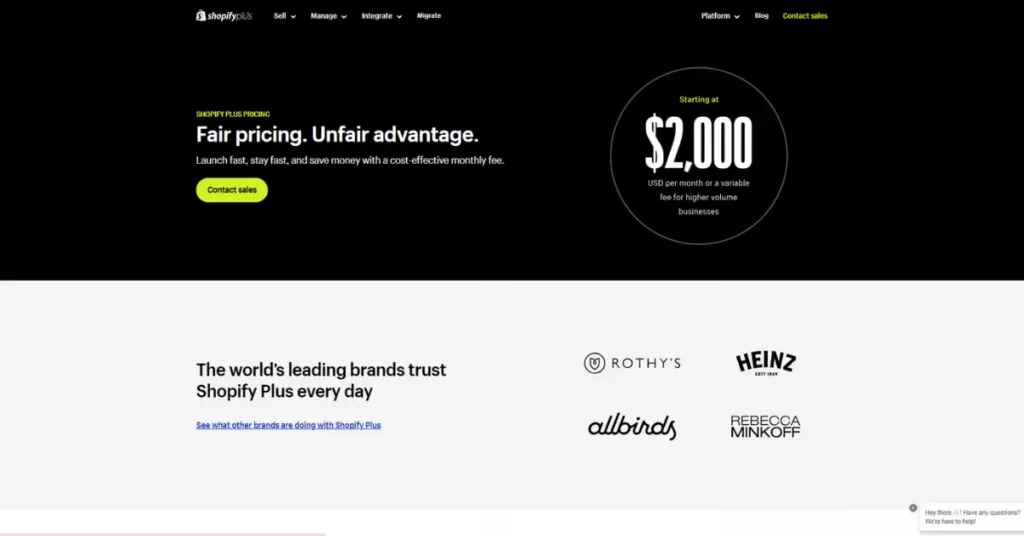
For large enterprises, the multi-store management feature is crucial and a primary consideration when selecting an eCommerce platform to sell globally. To engage in sales across various markets worldwide, your eCommerce website needs to be crafted to suit the preferences of each target audience in different markets.
This involves addressing issues related to language conversion, currency units, and payment methods with flexibility. Moreover, stores should be administered efficiently in a centralized manner rather than separately.
Shopify Plus allows you to create up to 9 additional storefronts alongside the main storefront at 1000 different inventory locations and 20 additional inventory locations. All these storefronts can be centrally managed through a single dashboard.
Plus, the Shopify Market feature will help you select the markets you want to sell in. The system will then automatically convert and manage multiple languages, currency units, shipping options, and payment methods based on the user’s IP address. Currently, Shopify Plus supports a range of local payment gateways, and you can refer to the provided list.

BigCommerce Enterprise doesn’t provide many solutions or features for global selling. Instead, it allows you to deploy multiple stores within the platform and then integrate with 3rd-party PIM solutions to manage data across these stores.
Another option is to leverage the BigCommerce Stencil framework to tailor content language for each local market. Also, the Enterprise version supports multi-currency payments through more than 250 local payment gateways.
The demand for adopting Headless eCommerce is on the rise, especially among large enterprises seeking to deliver a seamless and optimized experience for their customers. Both Shopify Plus and BigCommerce Enterprise offer effective solutions for going Headless.
BigCommerce Enterprise allows you to integrate with various frameworks (Next.js, Gatsby.js, Nuxt.js), APIs (REST, GraphQL), and your preferred or previously used tools.
When using Shopify Plus, there are three approaches. You can use the Storefront API to connect and develop with your preferred frameworks, hosting solutions, and tools. Or, you can leverage Shopify Hydrogen framework and Oxygen hosting to facilitate a headless eCommerce website flexibly.
Just like their regular pricing plans, both the ‘Enterprise’ and the ‘Plus’ include Point of Sale (POS) features for eCommerce transactions, catering to both online and offline stores, as well as Omnichannel operations.
POS can be configured on various devices like mobile devices (tablets, smartphones), and other hardware like cash registers and barcode scanners.
BigCommerce Enterprise offers smooth integration with third-party POS systems like Square, Vend, Clover, and Heartland Retail. It’s good for those who already using POS software from these third-party providers.
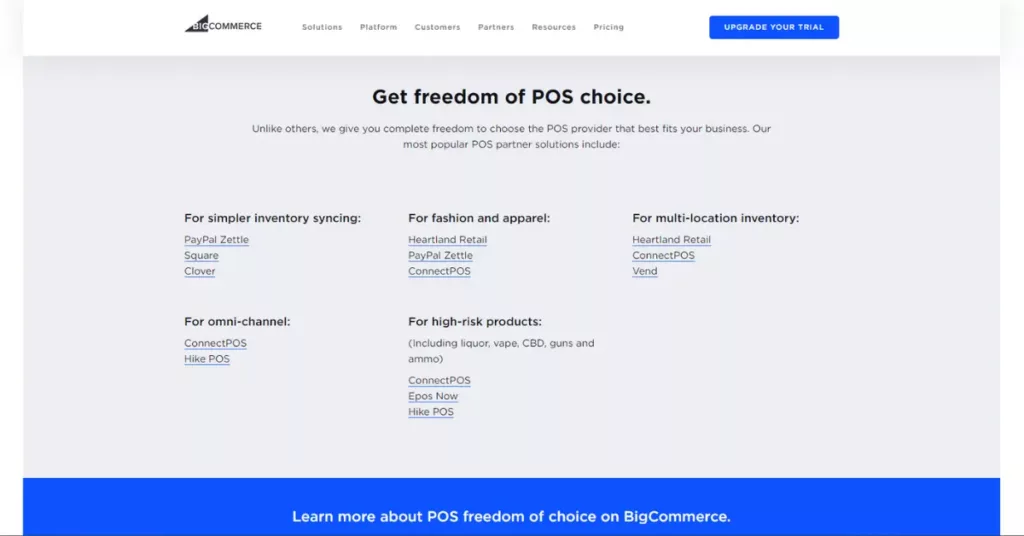
For Shopify Plus, beyond the option to integrate with third-party POS systems like BigCommerce Enterprise (Clover, Square, Zend), Shopify offers its own Shopify POS solution, available in two plans:
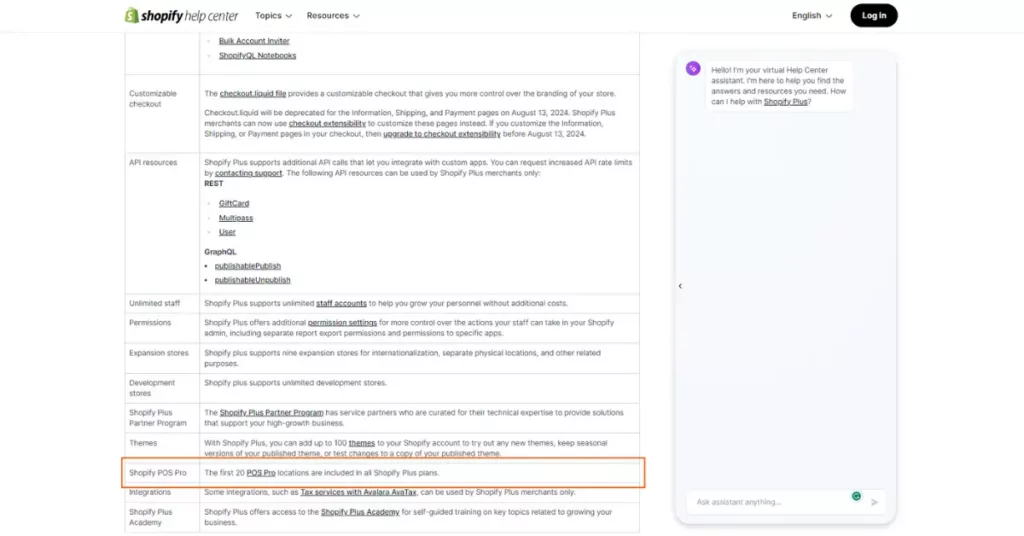
Both ‘Plus’ and ‘Enterprise’ offer tools and solutions to help you automate your eCommerce website operations.
Shopify Plus offers an exclusive solution, Shopify Flow, and LaunchPad, allowing you to automate routine tasks and set up automated workflows for tasks like email marketing campaigns or new product launches.
On the other hand, BigCommerce Enterprise takes a different automation approach which enables you to smoothly integrate with 3rd-party apps. Some of them are HubSpot, Avalara, ShipStation, etc.
SEO plays a crucial role in improving the search visibility of an eCommerce site and attracting potential customers. Both platforms offer features to enhance SEO efforts.
The ‘Plus’ stands out for its user-friendly interface and an integrated app ecosystem that can enhance SEO, incorporating tools such as Google Search Console and Analytics. However, it comes with limitations in URL control and customization.
The ‘Enterprise’, on the other hand, provides more versatile SEO capabilities, including complete control over URLs and integration with applications like Google Search Console and Analytics. It makes the process more intricate compared to Shopify Plus, involving additional setup operations.
Shopify Plus offers businesses approximately 12 free themes and 147 paid themes, with prices ranging from $150 to $380 per theme. On the other hand, BigCommerce Enterprise provides around 12 free themes and 185 paid themes, with prices ranging from $150 to $400 per theme.
Both platforms offer a wide range of visually appealing and mobile-friendly theme options. While the ‘Enterprise’ themes are characterized by elegant, tidy, and modern designs with highly customizable features, the ‘Plus’ themes can meet higher requirements for user experience, making navigation easier.
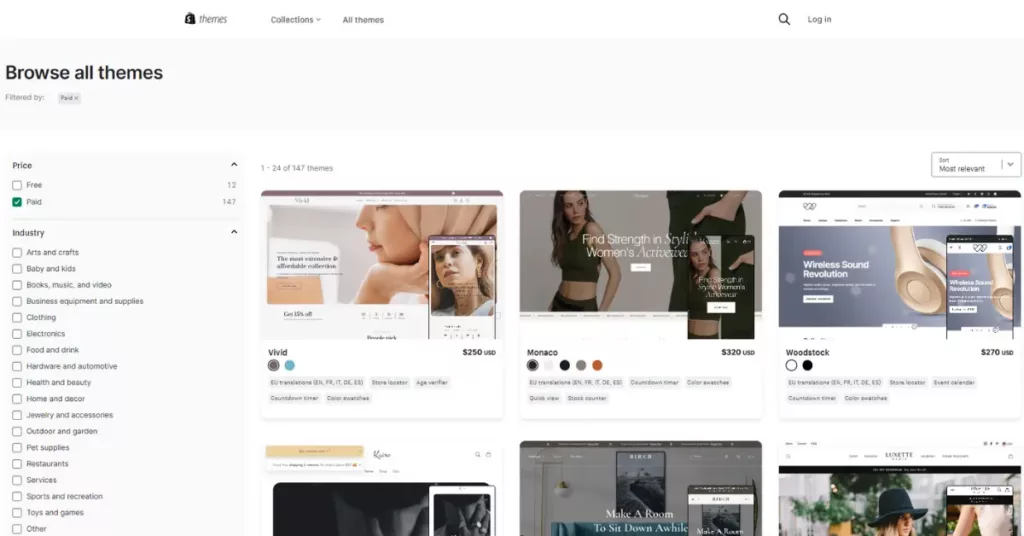
To facilitate efficient eCommerce deployment, the two provide vast app stores and extensions, tailored for ‘Plus’ and ‘Enterprise’ businesses. While both platforms offer free versions, access to comprehensive features requires a modest monthly fee.
Shopify Plus boasts over 6,000 apps and extensions, while BigCommerce Enterprise has around 1,000. This can be explained by Shopify’s widespread popularity among businesses and developers globally, providing them with ample documentation and resources for app and extension development, including the Shopify Plus Certified App Program.
For businesses that are ready to deploy the ‘Plus’ or the ‘Enterprise’ solutions, the demand for technical support and efficient eCommerce website operations is significant.
Both platforms receive high praise for their customer service. They offer 24/7 support via hotline, email, and video available in multiple languages. However, if you need specialized and complex technical support, Shopify Plus may be the preferable choice.
Final Thoughts
In the competitive business landscape, selecting the right platform for launching an eCommerce website is an important decision. Both Shopify Plus and BigCommerce Enterprise offer distinct advantages and cater to various business models.
Regardless of the platform chosen, you should prioritize the development and delivery of an exceptional shopping experience for your customers. eCommerce platforms serve as tools, and the ultimate key to success lies in an effective deployment strategy and great collaboration with a proficient team.
With extensive experience helping numerous businesses deploy diverse eCommerce development projects on both Shopify Plus and BigCommerce Enterprise, SECOMM boasts a team of seasoned experts capable of collaborating to create exceptional eCommerce experiences and help you enhance your brand positioning.
Reach out or directly call the hotline at 028 7108 9908 to explore how SECOMM can contribute to optimizing the potential of Shopify Plus and BigCommerce Enterprise for enduring your business success.
 2
2
 7,094
7,094
 0
0
 1
1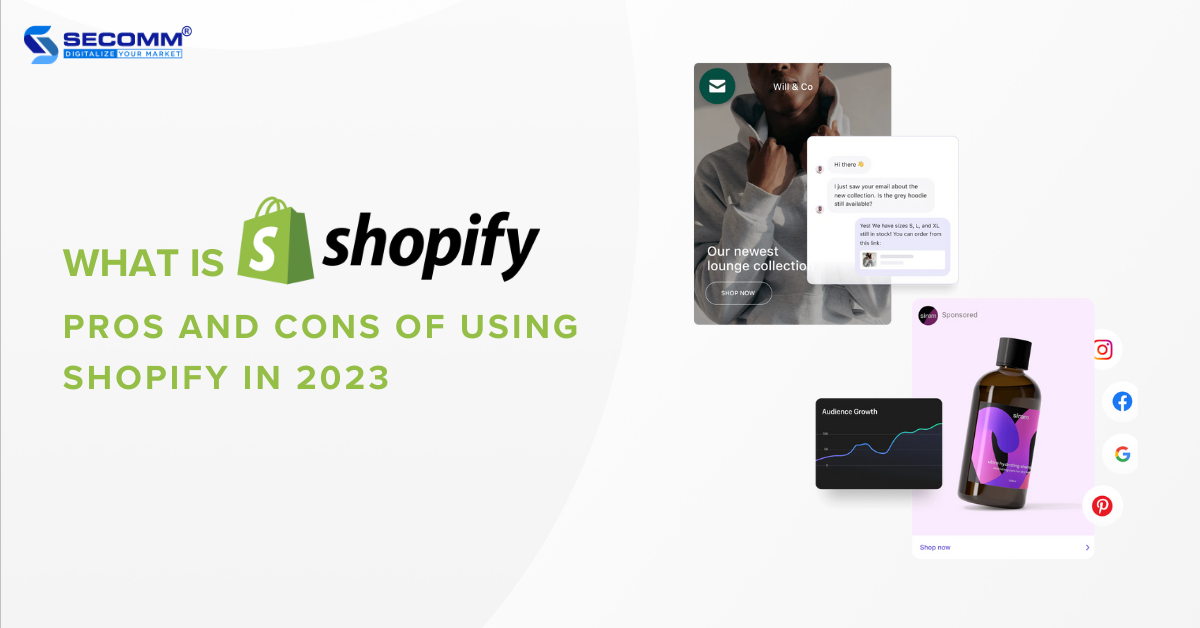
The eCommerce world is growing, and the significance of building and developing eCommerce websites has never been more crucial. Among the popular SaaS platforms, Shopify stands out as a name that commands attention.
Shopify is a SaaS platform and an outstanding solution that helps thousands worldwide turn their online business ideas into reality.
So, what is it? Why it is the top choice for eCommerce businesses, ranging from small-scale to large-scale operations. Let’s explore the power of Shopify in this article.
Shopify is a widely used eCommerce platform that allows businesses to build, develop, and manage their online store. With its user-friendly interface, even those with limited technical expertise can effortlessly navigate it easily.
Shopify operates as a Software as a Service (SaaS), requiring businesses to pay a monthly fee for usage and adhere to the platform’s regulations. However, the platform manages hosting and takes responsibility for technical issues, ensuring the security and efficient operation of the business’s eCommerce website.
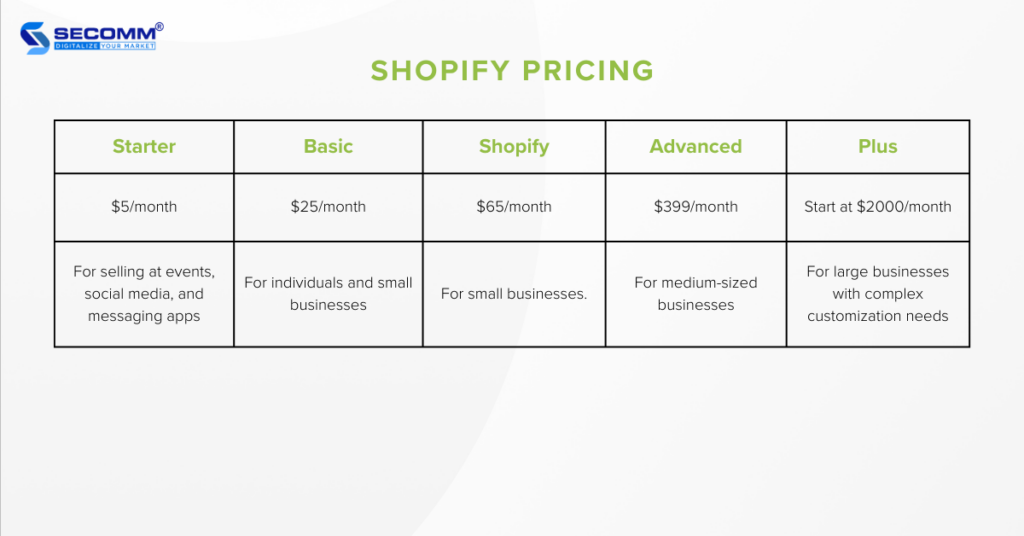
Until now, businesses have been familiar with 5 main solutions: Starter, Basic, Shopify, Advanced, and Plus. Recently, the platform introduced a new advanced solution called Commerce Components. This solution allows businesses to use the platform as a modular service, paying only for the features they need. It’s worth noting that this new solution is currently exclusive to the U.S. market.
For the Basic, Shopify, Advanced, and Plus plans, transaction fees are waived when businesses use Shopify Payments. However, in reality, this payment method isn’t available for all countries. Currently, it only supports countries in this list.
Conversely, transaction fees will apply at rates of 2%, 1%, 0.5%, and 0.15%, respectively. For the Starter plan, whether or not using it, transaction fees still apply and are relatively high at 5%.
Plus businesses using this payment method will enjoy no transaction fees. However, this exemption doesn’t apply to businesses in Austria, Belgium, and Sweden, even though these countries are included in the list.
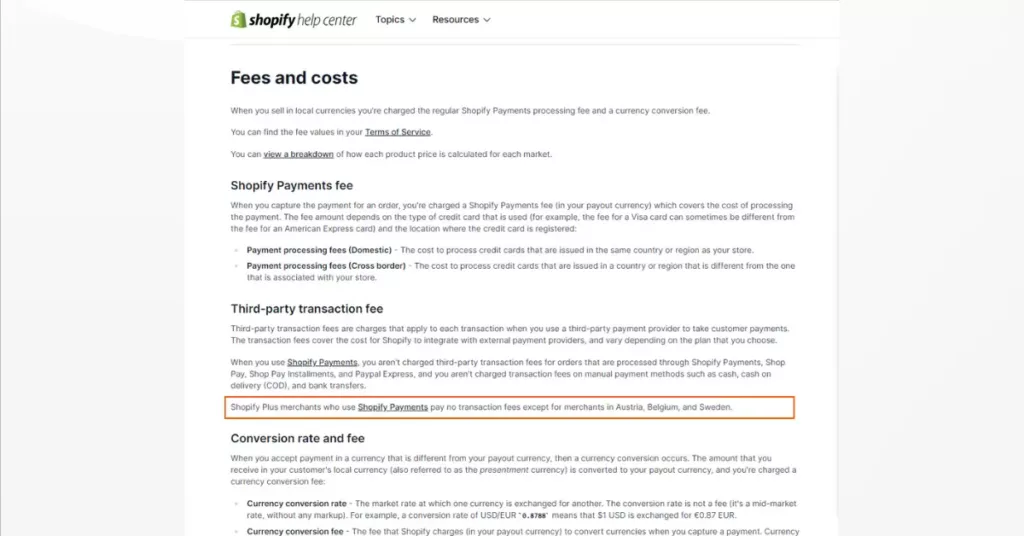
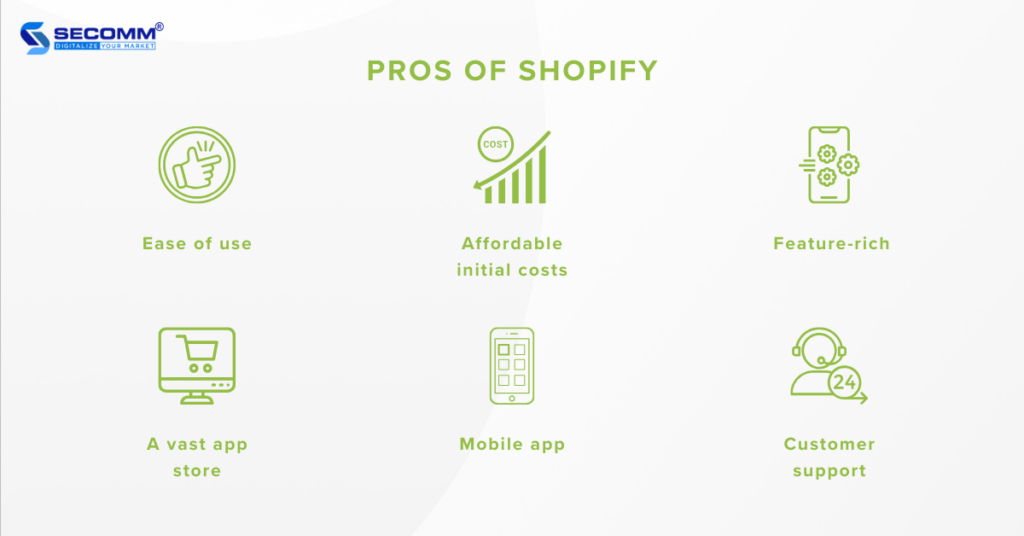
The platform is designed with an intuitive interface, allowing users with limited technical expertise to navigate it effortlessly. The platform offers a drag-and-drop editor, enabling businesses to easily add or remove products and make quick customizations.
Businesses also have the flexibility to customize layouts, colors, fonts, and font sizes, and add or remove elements and widgets from both free and premium themes.
Moreover, it offers businesses documentation and tutorial videos, ensuring a seamless and efficient setup and utilization experience.
The platform provides a range of cost-effective solutions suitable for startups and small to medium-sized businesses entering the eCommerce market. However, larger enterprises often prefer the Shopify Plus solution, given its reasonable costs of around $2,000, offering customization and scalability comparable to open-source platforms.
Moreover, as a SaaS platform, businesses pay a monthly fee for using it based on actual Gross Merchandise Volume (GMV), eliminating the need for a substantial one-time payment common with open-source platforms.
This is a versatile eCommerce platform suitable for businesses of all sizes and deployment needs. Whether for individuals, startups, or medium to large enterprises, it can provide features and tailored solutions to meet the specific needs of the business.
Some standout features that the platform brings to businesses include:
Beyond a diverse range of solutions and outstanding features, the platform offers businesses over 6,000 applications and integrations across various categories, from marketing, analytics, and shipping to inventory management and customer care. Each application is designed to address specific challenges and goals in the development of eCommerce.
Most applications and integrations in the App Store are developed by third-party businesses or independent developers. It provides resources, documentation, and tools for developers to create and release their applications on the store. While some apps offer a free version, it often comes with limited features, and businesses need to pay a monthly fee to access the full functionality.
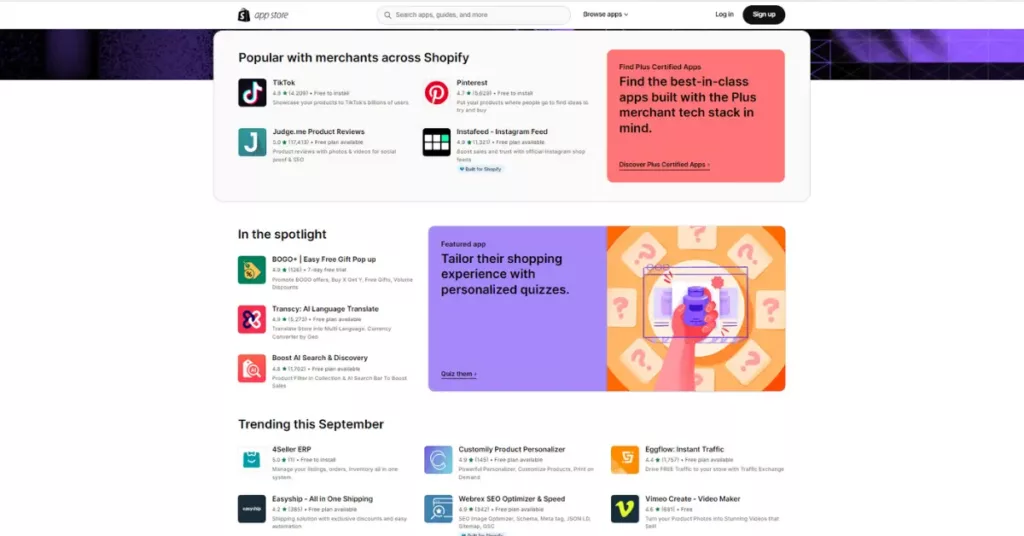
Compared to other SaaS platforms, Shopify provides businesses with up to three mobile applications for effective remote management of eCommerce operations:
The SaaS platform offers 24/7 customer support through chat, hotline, and email to address any customer issues throughout the eCommerce website development process. The level of support is equivalent for both small and large businesses. Moreover, it provides Shopify Experts services to offer businesses in-depth technical support, including web development, web design, marketing, and sales.
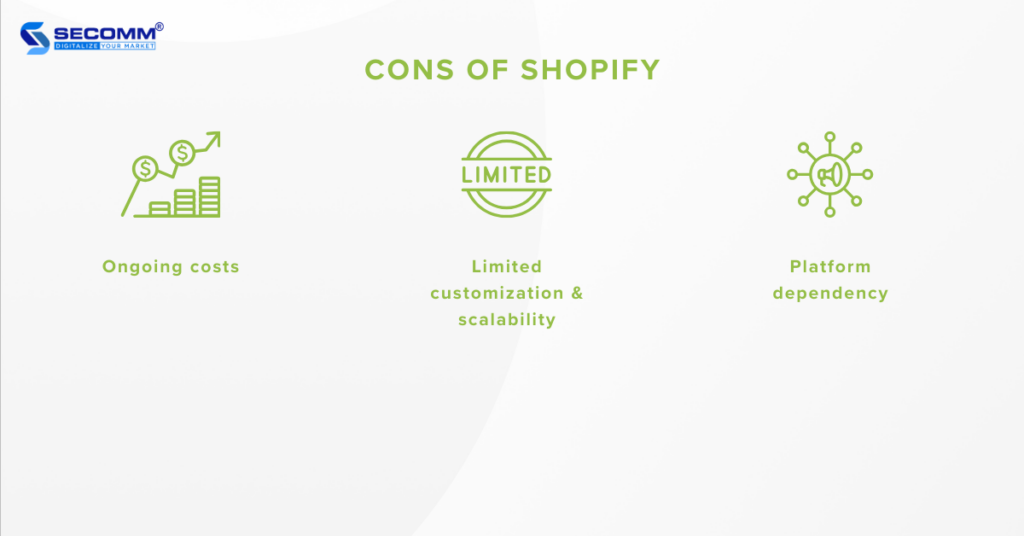
While the fees for using the plans seem reasonable, depending on the need for additional features, apps, or extensions, monthly costs may increase significantly, posing challenges for cash flow management, especially for larger businesses.
While this popular SaaS platform serves as a versatile eCommerce platform, its regular plans come with limitations in terms of customization and scalability. If a business requires a unique design or seeks freedom in designing the website interface, customizing themes on it can be restrictive and may require advanced programming skills.
Moreover, customizing third-party features and apps may add extra costs and dependencies. As an eCommerce website grows and expands, performance may be affected by increased traffic, accompanied by significant cost increases due to transaction fees (if not using Shopify Payments), app fees, and platform fees.
In such cases, the regular pricing plans (Basic, Shopify, Advanced) may not meet the business’s expectations for scalability, and businesses should consider transitioning to the Plus platform for long-term goals.
As a SaaS platform, Shopify has full control over the source code and data within the entire eCommerce website system. This means that all data related to the eCommerce operations will be locked into the platform’s database.
If it declares bankruptcy or ceases operations, all business data on this platform could be lost. However, this risk is highly unlikely. In the second scenario, when a business switches to another eCommerce platform, the exported data is typically provided in the form of a CSV file.
Get started with Shopify today!
When Tobias Lütke transformed Shopify from a snowboard-selling website to an eCommerce platform for businesses, he probably couldn’t have envisioned the significant impact it would have on the global business and technology landscape. The figure of 4.5 million active eCommerce websites is sure to increase substantially in the coming years.
Having accompanied many businesses, both domestically and internationally, in deploying Shopify website, the SECOMM team has accumulated extensive experience in web development and a deep understanding of the platform.
Contact SECOMM or call the hotline at 028 7108 9908 to get started!
 2
2
 7,049
7,049
 0
0
 1
1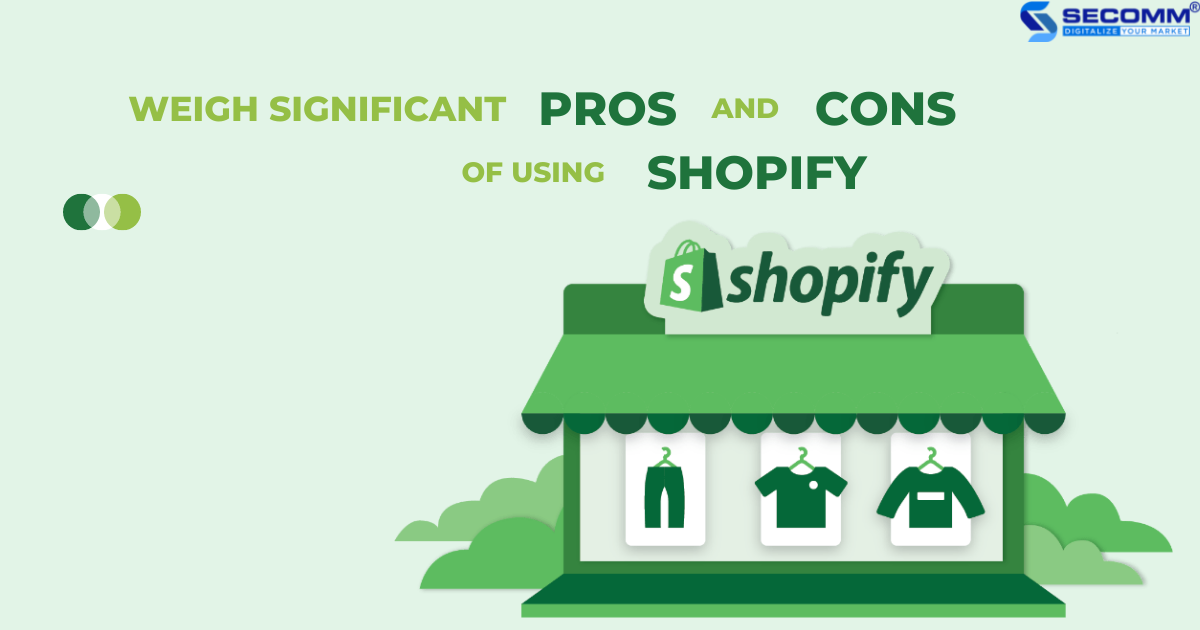
Today, for businesses of all sizes, eCommerce websites play an essential role in reaching and buying products for a wide pool of potential customers on the Internet.
Thus, choosing the right platform to build an eCommerce website is incredibly important. A good eCommerce platform will make it easy for businesses to provide Omnichannel experiences, personalize customer experiences, offer a variety of services, products, and more to increase conversions and drive online sales.
Some commonly mentioned platforms for building eCommerce websites are Magento, Woocommerce, Bigcommerce, etc. Definitely, each business will have its considerations, but one platform that always appears as a top choice is Shopify. In spite of the fact that the platform is highly rated, businesses should still weigh the pros and cons of this platform before making a final decision.
As a result, SECOMM has prepared this review, helping businesses understand what Shopify is, how it works, implementation costs, and especially the pros and cons of using this platform to build a comprehensive eCommerce website.
Before becoming one of the most popular eCommerce platforms globally, Shopify started as an online ski store called Snowdevil in 2004. Later, the company transformed into an eCommerce platform named Jaded Pixel.
In 2006, It was officially founded in Ottawa by young programmers Tobias Lutke, Daniel Weinand, and Scott Lake. Since then, the platform has gradually affirmed its position as a reliable and fastest-growing eCommerce platform in the last two years when most companies faced many difficulties because of the Covid-19 pandemic.
Up to now, the number of Shopify users has increased significantly. As reported by StoreLeads, there are currently about 2 million websites using the platform to build and develop online businesses. In the second quarter of 2022, the number of newly opened stores reached 150,928, an increase of 10.8% compared to the same period in 2021. In Vietnam alone, there are about 2,000 websites using the platform in operation, up 9.8% in the second quarter of 2022 over the same period in 2021.
Total revenue in the second quarter of 2022 reached $1.3 billion, up 16% over the same period in 2021, corresponding to a compound annual growth rate for three consecutive years of 53%. Gross profit in the second quarter of 2022 increased by 6% to $655.6 million compared to $620.9 million in the second quarter of 2021 (According to Shopify’s report).
While it is one of the most popular and user-friendly eCommerce platforms available today, businesses still need to determine if this is what they need to expand their business, all the advantages and disadvantages of the platform, mostly the cost issue.
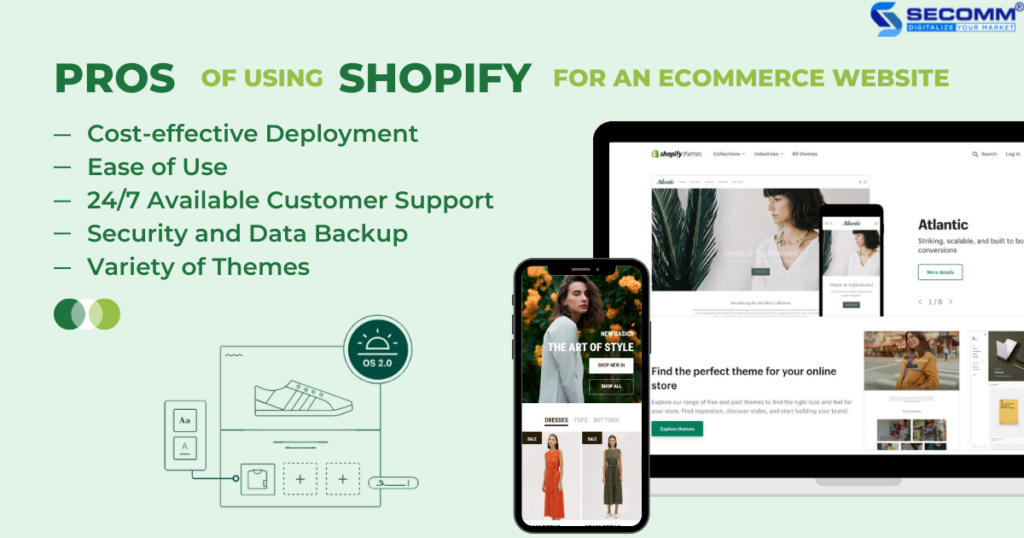
For a start, businesses can enjoy a 14-day free trial without a credit card requirement. When the free trial ends, businesses are encouraged to opt for one of the solution packages with suitable features and appealing promotions.
Packages | Price | Main Features | Unique Features | Ideally suited for |
Starter |
| Create product pages and get shareable links with product information, then send those links to customers via social platforms or message apps. | Merchants that sell on social platforms or message apps with no website in demand | |
Lite |
| – Shopify Buy Button. – Invoicing. | Merchants that sell on an existing website or social platforms. | |
Basic |
| – Customizable website editor. – Website hosting and free TSL certificate. – Unlimited number of products. – Analytical reports – Localization: currency conversion, website translation, regional domains. – Inventory Management. – Shopify POS. – Shopify Email. -Shopify Payment. – 24/7 Customer service. | – 2 staff accounts. – 4 inventory locations. – Basic reports. | Businesses who have just entered or intend to enter the eCommerce world and look for comprehensive eCommerce solutions. |
Shopify |
| – 5 staff accounts. – 5 inventory locations. – Standard reports. | Steadily growing eCommerce businesses. | |
Advanced |
| -15 staff accounts. -8 inventory locations. – Advanced reports. – Automation tools. | Large-scale businesses that sell internationally | |
Plus | Từ $2000/month. However, businesses can contact Shopify for a custom estimate. | – 9 expansion websites. – Up to 100 themes. – Exclusive Merchant Success Program, Shopify Plus Academy, Shopify Plus Partner , Shopify Plus Community on Facebook | Enterprise-level businesses that manage and operate multiple eCommerce websites. |
Table list of price, and features of Shopify solution packages.
First and foremost, because it is a SaaS platform, the cost to get started is usually quite low. Despite the fact that businesses must pay monthly fees, transaction fees, theme fees, and extension fees, Shopify is still significantly less expensive than open-source platforms such as Magento, WooCommerce, and others.
The development of an open-source platform necessitates the assistance of experienced programmers and takes a long time to deploy, whereas the SaaS platform is the inverse. That is the reason why starting with a SaaS platform, specifically, Shopify, will save businesses both time and expense.
Another cost highlight is that SaaS platforms, in general, and Shopify in particular, require an ongoing monthly fee rather than a one-time purchase fee to use the platform. This reduces the risk of businesses investing too much money in the platform but not meeting their expectations during the implementation process.
Furthermore, the Shopify platform is appropriate for different-sized businesses in the market. The Starter, Lite, and Basic packages are appropriate for SME businesses engaged in eCommerce. Shopify, Advanced, and Plus packages are ideal for large-scale businesses that require advanced features to run an effective eCommerce website.
The only way to adapt to the ever-changing market and quickly reach a wide pool of potential customers is for businesses to deploy eCommerce websites as soon as possible to avoid being left behind in the competition of the digital transformation race. One of the important factors when building an eCommerce website is choosing the right platform.
In particular, the top goal to consider when choosing an eCommerce platform is the ease of use. If a platform takes users too long to learn and implement or makes users dependent on external support, then the platform is not easy to use
Shopify has an easy-to-use interface for users with little programming knowledge. Moreover, Shopify is a SaaS eCommerce platform with a pre-designed system that offers hosting, interface, features, and technology infrastructure maintenance, allowing businesses to easily build and operate the website system with just drag and drop without worrying about technical issues.
Simple steps to get started with the eCommerce website implementation with Shopify:
This is one of the most crucial factors influencing users’ decision to use Shopify. Difficulties and obstacles are inevitable when building an eCommerce website, so Shopify has assembled a reliable and trusted team to assist users.
As a result, if your business requires assistance, assistance is available 24/7. Businesses can reach Shopify via email, chat, and a hotline worldwide. What’s more, users can access community forums and useful documents for developing eCommerce websites on this platform, mostly through the Shopify Support Center.
The Shopify platform runs on PCI (Peripheral Component Interconnect) compliant servers, allowing merchants to accept credit card payments. Secure Sockets Layer (SSL) encryption is enabled on all Shopify websites to secure visitor data, while a backup system allows businesses to store and save data regularly by exporting data to a CSV file.
As an outcome, the platform encourages the addition of an advanced backup solution from the Shopify Store, such as the Rewind app, as it is seen as a lifesaver if users accidentally delete content such as products or images or a video demonstration. To keep your eCommerce website secure, simply back up your data on a regular basis and use a strong enough admin password.
The interface is the appearance of a business’s eCommerce website. The more appealing the website interface, the more likely it is to retain customers, attract more visitors, as well as generate more conversions.
Shopify understands the importance of a website interface, so it has made a host of available themes, both free and paid, suitable for a wide range of businesses and fields, making it simple for businesses to choose from.
The free Shopify themes are ideal for startups, small and medium-sized businesses, and individuals. Businesses can customize their eCommerce website according to their needs and brand features by using features such as responsive web design, product filters, and product color display templates.
However, free themes have some downsides, including a limited number of themes, limited design, and a lack of advanced and specific features, which makes website customization difficult.
In fact, free themes are great for launching an eCommerce website. Premium interfaces, also known as paid themes, will be more suitable for large-scale businesses or businesses on the rise, with an average cost of around $140-$180/theme.
Shopify’s paid themes include advanced integration features such as live chat support, newsletter popups, upsell features, faster page loading, and much more. Thereby, businesses can run an eCommerce website automatedly and smoothly.
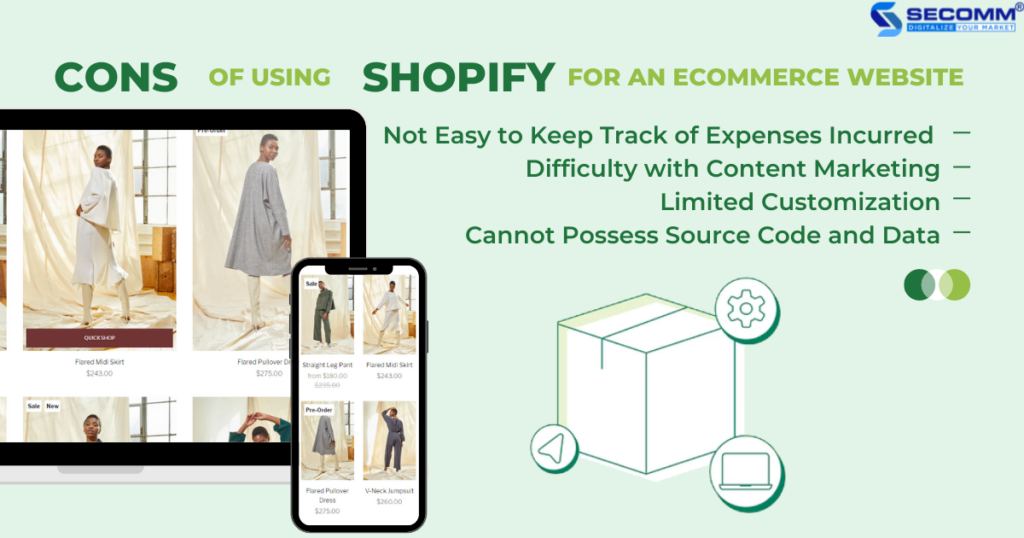
The cost of using Shopify, besides the notable pluses, the platform has a small but enough minus to make some businesses hesitate to start.
In addition to the monthly fee for using the enterprise platform, businesses must pay for other costs such as themes, applications, extensions, marketing features, sales, and SEO on a monthly basis with no long-term possession.
For example, to use the Free Shipping & Hello Bar application that offers free gifts, free shipping, or other types of promotions, users will buy for $8.95/month, which means ongoing monthly in regards to other expenses, businesses will pay an additional $8.95 for this app until it is no longer used.
When there are small expenses incurred each month, it is difficult to control cash flow for large-scale businesses that have to manage and operate many websites at the same time.
Meanwhile, open-source platforms require a one-time purchase fee rather than an ongoing monthly fee. Although the features are not yet available and take a long time to program, businesses can possess those features for eCommerce websites in the long run. Thereby, it makes cash flow management more convenient and effective.
It is a great way to promote your eCommerce website. Users can use Shopify to blog and optimize SEO, drive free traffic, and improve brand positioning.
However, this blogging feature on Shopify is not as user-friendly as WordPress. Some of the criteria Shopify can improve regarding blogging and content writing include:
This will be a barrier for businesses when using Shopify to promote eCommerce websites by optimizing SEO if the content is a core element of the business’s marketing strategy.
Another limitation of Shopify is that the platform’s interface is customized using the Shopify Liquid setup. Meanwhile, many website developers are already familiar with the PHP programming language to customize the themes and templates of the website, it is a common technique used by WordPress.
Therefore, users who do not have much experience in programming will face many obstacles when using Shopify’s tools to customize the interface of the eCommerce website.
However, businesses of all sizes can still use other useful Shopify features like Shopify Themes, Shopify App Store, Shopify Blog, 24/7 support team, and more to set up an eCommerce website quickly and effortlessly.
Because the entire business’s website system is hosted on Shopify’s server, the ownership and control of the website source code will belong to Shopify, not the business. Similar to other SaaS platforms such as BigCommerce, Squarespace, Wix… Shopify has a Lock-in feature, which means that when converting a website from one platform to another, businesses will no longer be able to use the old website source code and have to rebuild from scratch on a new platform.
Similar to the source code, business data is also stored on Shopify’s servers, so data ownership and control are quite limited. This makes it difficult for businesses to connect data among internal departments or users’ personalization, etc. Especially when switching platforms, data loss or misalignment is often unavoidable.
Shopify will not assist in the event that businesses stop using the platform for any reason. The only asset businesses can keep and take away is a CSV report containing website information.
Hence, before starting an eCommerce website on the Shopify platform, businesses need to carefully consider the benefits and disadvantages of stopping using it to conclude whether Shopify is the best fit for business in the long run.
Going by this article, Shopify is one of the eCommerce platforms that many businesses would love to choose when deploying an eCommerce website. However, besides the outstanding advantages, there are still certain downsides, so businesses need to carefully consider and compare with other platforms before starting out.
With many years of experience in implementing eCommerce in many countries, SECOMM provides free consulting services with professional eCommerce solutions.
Contact us today for free support and advice!
 2
2
 4,726
4,726
 0
0
 1
1Subscribe to get the latest eBook!
Hotline